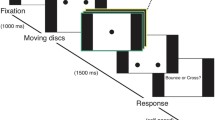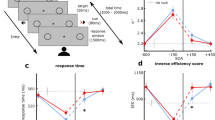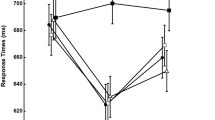Abstract
To perceive real-world objects and events, we need to integrate several stimulus features belonging to different sensory modalities. Although the neural mechanisms and behavioural consequences of intersensory integration have been extensively studied1,2,3,4, the processes that enable us to pay attention to multimodal objects are still poorly understood. An important question is whether a stimulus in one sensory modality automatically attracts attention to spatially coincident stimuli that appear subsequently in other modalities, thereby enhancing their perceptual salience. The occurrence of an irrelevant sound does facilitate motor responses to a subsequent light appearing nearby5,6,7. However, because participants in previous studies made speeded responses rather than psychophysical judgements, it remains unclear whether involuntary auditory attention actually affects the perceptibility of visual stimuli as opposed to postperceptual decision and response processes. Here we provide psychophysical evidence that a sudden sound improves the detectability of a subsequent flash appearing at the same location. These data show that the involuntary orienting of attention to sound enhances early perceptual processing of visual stimuli.



Similar content being viewed by others
References
Bertelson, P. & Aschersleben, G. Automatic visual bias of perceived auditory location. Psychon. Bull. Rev. 5, 482–489 (1998).
Stein, B. E., London, N, Wilkinson, L. K. & Price, D. D. Enhancement of perceived visual intensity by auditory stimuli: A psychophysical analysis. J. Cog. Neurosci. 8, 497– 506 (1996).
Stein, B. E. & Meredith, M. A. The Merging of the Senses (MIT Press, Cambridge, MA, 1993).
Welch, R. B. & Warren, D. H. in Handbook of Perception and Human Performance Vol. 1 (eds Boff, K. R., Kaufman, L. & Thomas, J. P.) 251, 25–36 (Wiley, New York, 1986).
McDonald, J. J. & Ward, L. M. Involuntary listening aids seeing: Evidence from human electrophysiology. Psychol. Sci. 11, 167–171 ( 2000).
Schmitt, M., Postma, A. & de Haan, E. Interactions between exogenous auditory and visual spatial attention. Q. J. Exp. Psychol. A 53, 105 –130 (2000).
Spence, C. & Driver, J. Audiovisual links in exogenous covert spatial orienting. Percept. Psychophys. 59, 1–22 (1997).
Mondor, T. A. & Amirault, K. J. Effect of same- and different-modality spatial cues on auditory and visual target identification. J. Exp. Psychol. Hum. Percept. Perform. 24, 745– 755 (1998).
Ward, L. M., McDonald, J. J. & Golestani, N. in Visual Attention (ed. Wright, R.) 232 –268 (Oxford Univ., New York, 1998 ).
Ward, L. M. Supramodal and modality-specific mechanisms for stimulus-driven shifts of auditory and visual attention. Can. J. Exp. Psychol. 48, 242–259 (1994).
Ward, L. M., McDonald, J. J. & Lin, D. On asymmetries in crossmodal spatial attention orienting. Percept. Psychophys. 62, 1258– 1264 (2000)
Driver, J. & Spence, C. Attention and the crossmodal construction of space. Trends Cog. Sci. 2, 254– 262 (1998).
Driver, J. & Spence, C. Crossmodal attention. Curr. Opin. Neurobiol. 8, 245–253 (1998).
Sperling, G. & Dosher, B. A. in Handbook of Perception and Performance Vol. 1 (eds Boff, K. R., Kaufman, L. & Thomsas, J. P.) Ch. 2.1, 2–65 (Wiley, New York, 1986).
Shiu, L. & Pashler, H. Negligible effect of spatial precuing on identification of single digits. J. Exp. Psychol. Hum. Percept. Perform. 20, 1037–1054 ( 1994).
Pashler, H. E. The Psychology of Attention (MIT Press, Cambridge, MA, 1998).
Green, D. M. & Swets, J. A. Signal Detection Theory and Psychophysics (Wiley, New York, 1966).
Luck, S. J., Hillyard, S. A., Mouloua, M. & Hawkins, H. L. Mechanisms of visual-spatial attention: Resource allocation or uncertainty reduction? J. Exp. Psychol. Hum. Percept. Perform. 22, 725–737 (1996).
Luck, S. J. & Thomas, S. J. What variety of attention is automatically captured by peripheral cues? Percept. Psychophys. 61 , 1424–1435 (1999).
Santee, J. L. & Egeth, H. E. Do reaction time and accuracy measure the same aspects of letter recognition? J. Exp. Psychol. Hum. Percept. Perform. 8, 489–501 ( 1982).
Meredith, M. A., Nemitz, J. W. & Stein, B. E. Determinants of multisensory integration in superior colliculus neurons. I. Temporal factors. J. Neurosci. 7, 3215–3229 (1987).
Dufour, A. Importance of attentional mechanisms in audiovisual links. Exp. Brain. Res. 126, 215–222 (1999).
Mills, A. W. On the minimum audible angle. J. Acoust. Soc. Am. 30 , 237–246 (1958).
Acknowledgements
We thank D. Heraldez for research assistance, M. M. Marlow for computer assistance and L. Anllo-Vento for comments on the manuscript. This work was supported by grants from the National Institute of Health.
Author information
Authors and Affiliations
Corresponding author
Rights and permissions
About this article
Cite this article
McDonald, J., Teder-Sälejärvi, W. & Hillyard, S. Involuntary orienting to sound improves visual perception. Nature 407, 906–908 (2000). https://doi.org/10.1038/35038085
Received:
Accepted:
Issue Date:
DOI: https://doi.org/10.1038/35038085
- Springer Nature Limited
This article is cited by
-
Cortical adaptation of the night monkey to a nocturnal niche environment: a comparative non-invasive T1w/T2w myelin study
Brain Structure and Function (2022)
-
Choice-dependent cross-modal interaction in the medial prefrontal cortex of rats
Molecular Brain (2021)
-
Cross-modal orienting of exogenous attention results in visual-cortical facilitation, not suppression
Scientific Reports (2021)
-
Facial speech processing in children with and without dyslexia
Annals of Dyslexia (2021)
-
Auditory stimuli degrade visual performance in virtual reality
Scientific Reports (2020)





